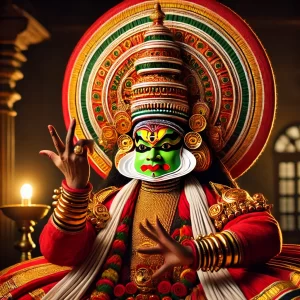
-
Introduction
-
Overview:
-
Introduce Kerala’s rich cultural heritage and its renowned traditional arts.
-
Emphasize the significance of performing arts in festivals and cultural celebrations.
-
-
Focus Areas:
-
Primary emphasis on Kathakali and Mohiniyattom, with supplementary insights into various folk dances and ritual art forms.
-
2. Kathakali: The Grandeur of Storytelling
-
Essence and Origins:
-
A classical dance-drama known for its elaborate makeup, vivid costumes, and expressive facial gestures.
-
Rooted in the traditional temple arts, Kathakali transforms mythological stories into visual epics.
-
-
Performance Elements:
-
Costume and Makeup: Intricate designs that symbolize various characters and their traits.
-
Gestures and Movements: Highly stylized hand and body movements that communicate deep emotions and narrative cues without words.
-
Musical Accompaniment: Live percussion, flutes, and vocalists that complement the dramatic narrative.
-
-
Cultural Significance:
-
Serves as a medium to preserve ancient epics and legends, reflecting Kerala’s spiritual and historical narratives.
-
Often performed during major festivals, showcasing the artistic mastery and rigorous training of its practitioners.
-
3. Mohiniyattom: The Dance of Enchantment
-
Essence and Origins:
-
A classical dance form that embodies grace, subtlety, and feminine charm.
-
Originates from the temples of Kerala, celebrating the divine feminine.
-
-
Performance Elements:
-
Graceful Movements: Slow, flowing gestures that emphasize fluidity and poise.
-
Expressive Storytelling: Minimalist yet emotionally powerful expressions that narrate tales of love and devotion.
-
Costume and Music: Elegant costumes paired with soft, melodic music that enhance the ethereal quality of the performance.
-
-
Cultural Significance:
-
Represents the refined aesthetic of Kerala’s classical arts and highlights the role of women in cultural traditions.
-
Performed during temple festivals and cultural events, symbolizing beauty, devotion, and artistic finesse.
-
4. Folk Dances: The Vibrancy of Community Traditions
-
Kanniyar Kali (Desathukali):
-
Devotional Roots: Performed in honor of the Goddess Bhagvaty, it features rapid, energetic movements set to devotional tunes.
-
Community Expression: Often enacted during temple festivities to invoke divine blessings.
-
-
Kaikotti Kali (Thiruvathirakali):
-
Circular Harmony: A women’s dance performed in coordinated circles during celebrations like Thiruvathira and Onam.
-
Rhythmic Elegance: Characterized by synchronized clapping and graceful movements that highlight communal unity.
-
-
Kuthiyottam:
-
Temple Tradition: A ritual dance from Thiruvananthapuram performed by a small group in front of deities.
-
Narrative Chants: Integrates sacred chants and rhythmic chants that elevate the spiritual ambience of the performance.
-
-
Thirayattam:
-
Torch-lit Spectacle: Performed during temple festivals known as kavus, it involves dynamic movements with torches, symbolizing purification and energy.
-
-
Kakkarissi Kali:
-
Energetic Community Dance: Carried out by the Kuravas community, this high-spirited dance is marked by vigorous movements and enthusiastic participation, often accompanied by percussion instruments.
-
5. Percussion and Group Dances: Rhythm of Kerala
-
Dappu Kali:
-
Instrumental Focus: Centered on the dappu drum, dancers form two parallel rows and exchange positions in a coordinated performance.
-
Celebratory Rhythm: Emphasizes the collective spirit of the community with its structured yet dynamic choreography.
-
-
Kolkali:
-
Agrarian Roots: A lively group dance traditionally performed by the farming community, using sticks to create rhythmic clashes in circular formations.
-
Symbol of Unity: Reflects the communal nature of rural life and the harmony of collective labor.
-
6. Martial and Ritual Arts
-
Kalaripayattu:
-
Ancient Martial Art: A dynamic display of combat techniques that blends physical agility with disciplined strategy.
-
Cultural Legacy: Often performed as a demonstration of historical martial prowess, it embodies the warrior spirit of Kerala.
-
-
Additional Ritual Performances:
-
Parichamuttu Kali: A spirited performance marked by playful interactions, often seen during temple festivities.
-
Sarpam Thullal: A ritualistic act combining storytelling and satire, with an emphasis on mythological symbolism involving serpents.
-
Poorakkali: A devotional dance performed by men during Onam, known for its energetic choreography and celebratory spirit.
-
7. Integration of Traditional Arts in Contemporary Festivals
-
Cultural Revivals:
-
Festivals such as Onam, Thrissur Pooram, and Navaratri serve as grand stages for these traditional art forms.
-
Modern reinterpretations and fusion performances help preserve ancient traditions while appealing to younger audiences.
-
-
Community and Educational Impact:
-
These art forms are not only cultural expressions but also serve educational purposes, teaching history, mythology, and moral values through performance.
-
Workshops and cultural academies across Kerala actively promote the training and transmission of these traditional arts to new generations.
-
8. Challenges and Preservation Efforts
-
Sustaining Interest Among Youth:
-
Contemporary influences and digital entertainment pose challenges in keeping traditional arts vibrant.
-
Government and cultural organizations are initiating programs to engage younger audiences through modern adaptations and educational initiatives.
-
-
Preservation and Innovation:
-
Collaborative projects between government bodies, cultural institutions, and private patrons are working to document, preserve, and innovate traditional art forms.
-
Festivals and competitions offer platforms for emerging artists to showcase their talents and carry forward these ancient traditions.
-
9. Conclusion
-
Cultural Wealth:
-
Kerala’s traditional arts, with Kathakali and Mohiniyattom at the forefront, are a testament to the state’s rich cultural heritage.
-
These art forms continue to evolve while maintaining their unique identity and significance in festivals and daily life.
-
-
Future Prospects:
-
With ongoing preservation efforts, educational initiatives, and community engagement, Kerala’s traditional arts are poised for a renaissance.
-
The deep-rooted cultural legacy not only enhances Kerala’s festive landscape but also reinforces its status as a cultural beacon on the global stage.
-
This outline provides a fresh and detailed structure for your article titled “Kerala’s Culture and Festivals: A Deep Dive into the Traditional Arts,” with an emphasis on classical forms like Kathakali and Mohiniyattom while also incorporating a broader view of Kerala’s rich folk traditions and performance arts.
